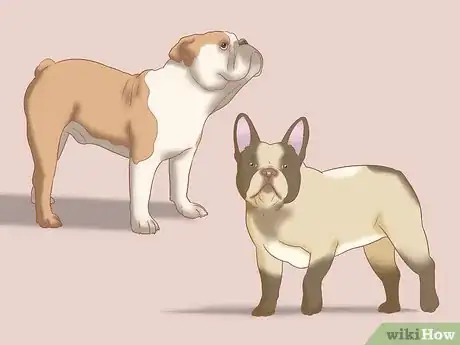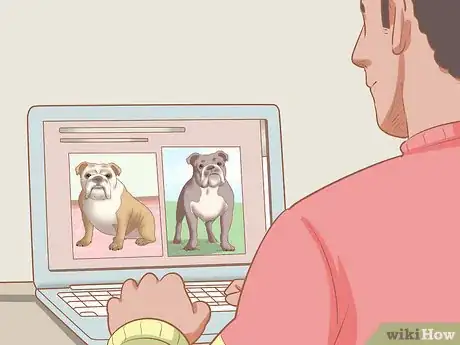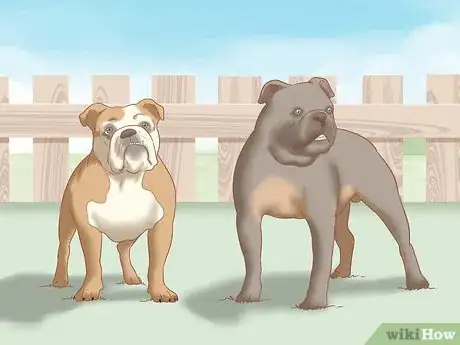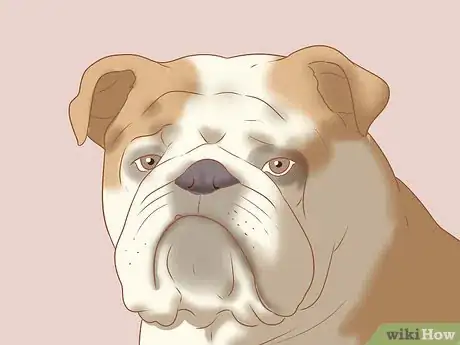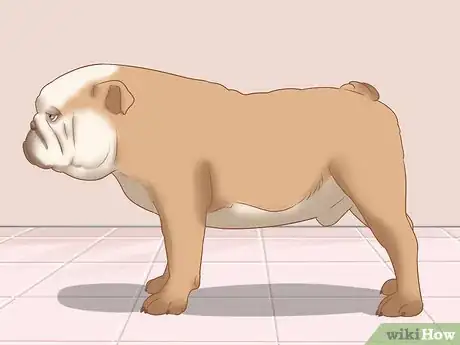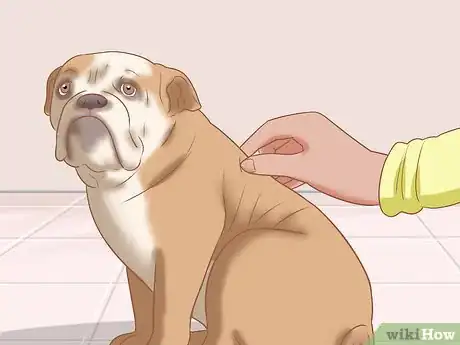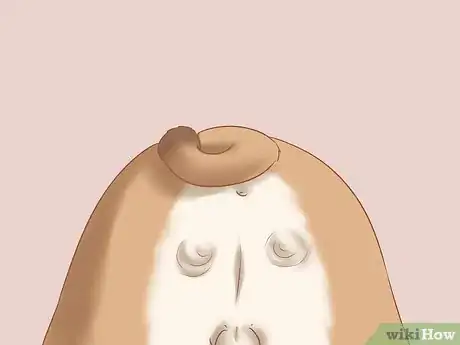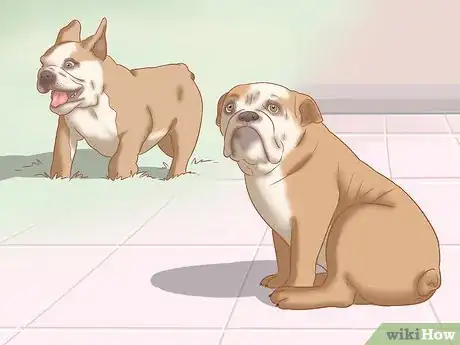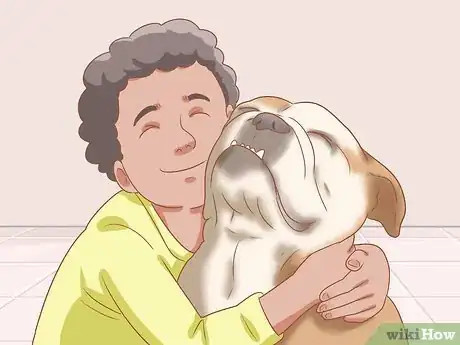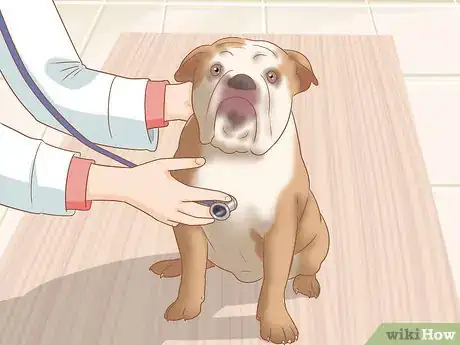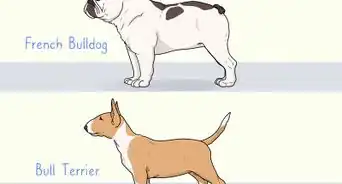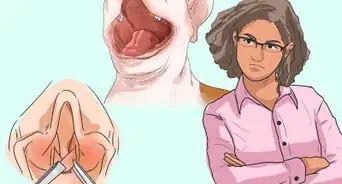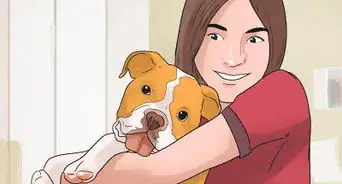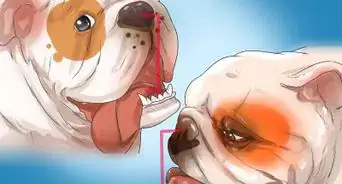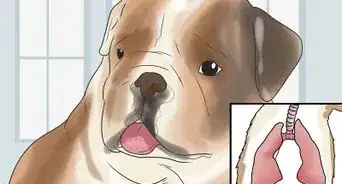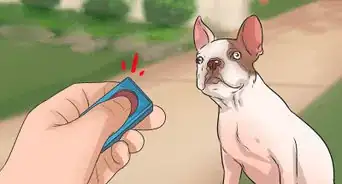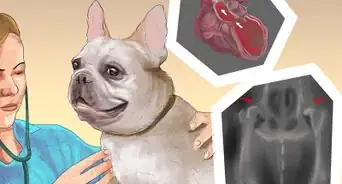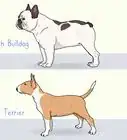This article was co-authored by David Schmucker. David Schmucker is a Dog Trainer and a Senior Trainer at Sidewalk Dog Training in Washington D.C. With over 17 years of experience, David specializes in canine training programs such as dog aggression training, dog behavioral correction, and dog separation anxiety training. David holds a BS in Personnel & Labor Management from the University of Maryland.
There are 10 references cited in this article, which can be found at the bottom of the page.
wikiHow marks an article as reader-approved once it receives enough positive feedback. In this case, 100% of readers who voted found the article helpful, earning it our reader-approved status.
This article has been viewed 72,914 times.
English Bulldogs are unique, even amongst bulldogs. Bulldogs have surged in popularity across the US and the world, and that is thanks in large part to the unique physical features of the English Bulldog.[1] Known for their round bodies, squashed faces, rolls of skin, and kind, affectionate personality, the English Bulldog is widely loved and very recognizable. You simply need to know a couple of key physical and social features to differentiate it from other bulldogs.
Steps
Determining the Type of Bulldog
-
1Examine bulldog breeds. There are a number of bulldog breeds out there, many of which share similar physical characteristics due to having the same heritage. Look at an online breed guide or purchase a guide at a local pet store to help you recognize different types of bulldogs.[2]
- English bulldogs are easily confused with other short, squat forms of bulldog such as the Victorian Bulldog, the Dorset Olde Tyme Bulldog, and the the Aussie Bulldog.
- Take a look at body shapes. Some bulldogs have lean, muscular bodies and longer noses and faces. These types of bulldogs, such as the American Bulldog and the Banter Bulldog, look more like pit bull type dogs than they do a short, round English Bulldog.
- French bulldogs are often smaller than English bulldogs and have upright, pointed ears.
-
2Look at pictures. Go online or look for resources at your local pet store with pictures of different types of bulldogs. Seeing representations of different types of bulldogs can help you learn what to look for in an English bulldog.
- Put pictures of similar bulldogs side-by-side and take a close look to find some of the differences. Look at body shape, facial features, ears, and tail to help give you an idea.
Advertisement -
3Differentiate between types of English Bulldogs. There are two types of English Bulldogs out there, and while they can look similar, they have some differentiating features. The Olde English Bulldog is known for being larger, taller, and somewhat more muscular than its modern cousin.[3]
- Despite the name, Olde English Bulldogs are still actively bred and raised today. It is possible to come across both an English Bulldog and an Olde English Bulldogge at a rescue or with a breeder.
- Olde English Bulldogs have been cross-bred with bull mastiffs, pit bulls, and American bulldogs to help keep them healthier and avoid some of the complications common amongst regular English Bulldogs.
Discerning English Bulldog Physical Traits
-
1Look at the head. Many of the English Bulldog’s defining characteristics are part of their distinct face. Take a look at the skull shape, the forehead, the nose, the shape of the ears, and the jawline.[4]
- English Bulldog skulls tend to be large and round, with broad foreheads and a short, straight line running from the top of the head to the nose. Their foreheads aren’t usually round and their faces are generally flat.
- English Bulldog ears generally have short, pointed, floppy ears, sometimes called “rose ears.” English Bulldogs do not have long ears, but unlike other short, pointy-eared breeds, their relaxed ears fall to the side of their head rather than standing upright.
- English Bulldogs tend to have a pronounced, turned up jaw despite their short muzzle. This can sometimes lead to an underbite, though not always.
-
2Examine the body shape. An English Bulldog should have a broad, round body with wide shoulders and a full chest that makes its front legs appear somewhat shorter than the back. Behind the ribs, the belly should be tucked up rather than rounded, and the back should follow a curve with the head and hindquarters higher than the middle of the back.
- English Bulldogs are generally rounder and closer to the ground than other bulldog breeds. They should look stout and muscular, but are not necessarily inherently lean dogs.
-
3Feel the coat. An English Bulldog has a short, flat, smooth coat with little to no feathering or curling. English bulldogs can have many different colors or markings, but generally predominantly feature white and brown marks across the body.[5]
- In addition to the coat, the loose skin around the head, neck, and shoulders is a good indicator of an English Bulldog, as other bulldogs do not always possess such rolls.
- English Bulldog coats can come in many colors, but are most commonly white with large brown spots or patches across the body.
-
4Check the tail. Most English Bulldogs do not have long tails. Rather, they have short, low-hung tails that follow the curve of the spine down toward their hindquarters. Bulldog tails may be straight, or have a slight upturn, or “screw,” to the end of them.[6]
- While English Bulldog tails may have a screw, rarely do they actually curl. A curled tail on an English Bulldog might be an indicator of cross-breeding.
Establishing English Bulldog Personality Traits
-
1Watch energy levels. Like most dogs, English Bulldogs tend to be enthusiastic as puppies, but as they mature they will slow down. Many adult English Bulldogs have bursts of energy a couple times a day, but do not stay consistently energetic throughout the day.[7]
- Their unique physical features often make extended exercise difficult for English Bulldogs. Watch for snorting and panting as signs of exhaustion.
-
2Look for gentle demeanors. English Bulldogs are generally loyal, affectionate, and gentle dogs, often cited as being good with children and other dogs. Watch a bulldog’s daily interactions to see if they are gentle, affectionate, and moderated like those of an English Bulldog.[8]
- English Bulldogs tend to be more attention-oriented than some other bulldog breeds. They will actively seek attention from people, rather than waiting for a person to come to them.
-
3Anticipate bravery. While loyal and affectionate, English Bulldogs also retain the bravery for which they were originally bred. They will often seek out the role of watchdog, and will try to protect their family from unfamiliar threats, including new people or new dogs.[9]
- English Bulldogs can be particularly protective of small children or other small animals. They are sometimes even known to protect children from scolding or angry parents.
-
4Have a vet check for medical problems. All breeds of bulldogs tend to suffer from the same medical conditions, but the flat face and round body of English Bulldogs make them especially susceptible. Have a vet check a potential bulldog for medical issues such as hypothyroidism and arthritis, typical of English Bulldogs.[10]
- The most common medical problems seen amongst English Bulldogs are hypothyroidism, heart disease, allergies that lead to itchy skin, and eye problems including cataracts.
- The folds and extra skin around the face, along with the short muzzle, are some things that can cause breathing inhibition.When you have a Bulldog, you're gonna get snoring and breathing difficulties.
Community Q&A
-
QuestionWhere should a bulldog's ears be situated on their head at birth?
 LinnieTop AnswererA bulldog's ears sit high on the dog's head and fall to the sides of the head.
LinnieTop AnswererA bulldog's ears sit high on the dog's head and fall to the sides of the head. -
QuestionWhy is one ear black and one white?
 LinnieTop AnswererIt's possible and not too uncommon for bulldogs to have two different colored ears, such as black and white.
LinnieTop AnswererIt's possible and not too uncommon for bulldogs to have two different colored ears, such as black and white. -
QuestionWhat do you mean by a crossbreed if tail is small and curls in?
 LinnieTop AnswererEnglish bulldogs have screwed tails rather than curled tails. Screw tails are described as naturally short tails twisted in a spiral formation, while curled tails are typically longer and curled over the back or side. If an English bulldog has a curled tail, this is likely the result of mixed breeding.
LinnieTop AnswererEnglish bulldogs have screwed tails rather than curled tails. Screw tails are described as naturally short tails twisted in a spiral formation, while curled tails are typically longer and curled over the back or side. If an English bulldog has a curled tail, this is likely the result of mixed breeding.
References
- ↑ http://www.reuters.com/article/us-usa-dogs-breeds-idUSBREA0U1N520140131
- ↑ http://bulldogbreeds.bulldoginformation.com/different-bulldog-breeds-types.html
- ↑ https://www.cuteness.com/article/olde-bulldog-vs-english-bulldog
- ↑ http://www.akc.org/dog-breeds/bulldog/
- ↑ http://www.dogbreedinfo.com/bulldog.htm
- ↑ http://www.cashsbullbabies.com/bulldogstandard3.html
- ↑ https://pethelpful.com/dogs/Your-Guide-to-English-Bulldog-Puppies
- ↑ http://www.hillspet.com/en/us/dog-breeds/english-bulldog
- ↑ http://www.bulldoginformation.com/temperament-personality-character.html
About This Article
To identify an English Bulldog, start by examining the body and looking for a round build, broad shoulders, and a short, low hung tail, which are all characteristics of the breed. You should also look for a wide forehead with a straight line running from the nose to the top of the head. Additionally, check for loose skin around the head, neck, and shoulders. Then, observe the dog’s personality, since these are affectionate, gentle dogs that actively seek attention from people. For more tips, like how to tell the difference between an English Bulldog and an Olde English Bulldog, read on!
